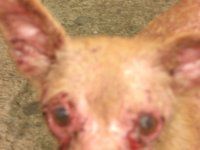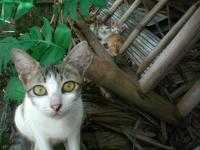Fleas: Friend or Foe?
Sponsored Links
Also, published in July, 1995, issue of my newsletter called
Animal Taleswas an article about fleas. My first ever article about fleas — a common problem that really doesn't need to be a problem.
Fleas are a common problem that all too many of our four legged companions can do without.
Typically speaking, when a dog or cat has a flea problem, we as guardians of dogs and cats prepare for battle with the blood sucking parasite we call the flea. The use of flea sprays, flea shampoos, and flea collars make the foundation of the arsenal used to kill fleas. Further action can be taken by spraying the house with insecticides. Veterinarians also have up to date information on how to control the spiny, strong legged fleas using modern technology. But what good does all of this do? Does it solve the flea problem? Can it have adverse effects on our companion's health? Can we solve the flea problem using non–invasive methods that attack the problem rather than the symptom?
About two years ago, when I was at a flea market (no pun intended), I met this lady who was a Native Canadian from a band that borders the B.C., Alaska and Yukon border. Out of curiosity, I asked how her forefathers survived in conditions where black flies and mosquitoes lived in such great numbers without getting bit to death or going insane from all the little creatures buzzing around their head?
Anyone who has been in the bush up north during the summer months probably knows why I asked this question. Hoping to find some miracle remedy to get rid of the black flies and mosquitoes, I was surprised with her response. She stated that her forefathers never had a problem. She went on to say that the bug problem is a basically a result of modern pollution and damage to the environment.
Most people are not aware that fleas, like many insects, parasites, bacteria, plant life and other bugs build resistance over a period of time to the use of chemicals. Thus this explains why many people still experience a flea problem after spraying or shampooing with insecticides. True, many times the problem is alleviated for a while, but when the problem comes back, it's now worse than ever and harder to deal with. So where does this leave us? Back where we started with yet another flea problem.
What should you do? Well, if you go to your veterinarian, your animal friend will probably receive a cortisone shot. Cortisone does nothing except provide symptomatic relief of the problem. Cortisone which can interfere with the body's ability to absorb vitamin A and C; can cause a potassium deficiency, and may lead to liver and/or kidney problems is no solution.
Also, before we forget, what does the use of chemical pesticides do to our companions?
The answer is simple, if the label states for external use only and should not be exposed to your skin, what on earth are we doing using these kind of products on our animals?
Flea sprays, shampoos, collars and so on do more damage to our dogs and cats than to actually solving the flea problem, and we wonder why so many dogs and cats suffer from kidney and liver problems; or suffer from chronic disease.
The good news is we can't worry about what has been done in the past. We should focus on the present. We're never going to get rid of all the fleas in the world, and truthfully it would be sad if we did. Fleas and other parasites serve a role in Mother Nature's scheme of thing. So what should we do?
We should be glad in an uncanny way that our companion has fleas. Fleas are a sign of a problem. We should not look at fleas as being the problem. True, fleas can pass tapeworms (healthy animals should not get tapeworms) into the system of our animals and can even cause anemia, but ultimately they are our friends because they're letting us know that our companions are not healthy.
An unhealthy system has a low immune system and lacks vitamins and minerals. Thus, really the problem is an unhealthy body with the symptom being a flea infestation.
To treat the problem we must solve the malnutrition. Contrary to popular belief, commercial pet foods are not complete, if they were, we wouldn't be seeing so many cases of chronic disease in dogs and cats today.
Commercial pet foods may contain unnecessary preservatives and lack real nutrition. Since 90% of disease is nutritionally related, the goal of every dog or cat guardian should be to feed a quick and simple homemade diet that contains maximum nutrition and is natural.
A homemade diet simulates what dogs and cats would get in the wild, does not take long to prepare and is extremely affordable, especially when you consider veterinarian bills become virtually non–existent as now the animal is amazingly healthy.
Before feeding a ridiculously simple homemade diet, you should learn how to make the food properly. When we begin to understand animal nutrition we realize that fleas (and other problems like ringworm) are a definite sign that body is lacking sulfur in the cells of the body. The good news is when we begin feeding a homemade diet with maximum nutrition, we put sulfur into the cells.
To compliment a good natural diet, we should also be bathing the dog (sometimes cats depending on their temperament) with a good all–natural shampoo. Whichever shampoo you use, make sure it does not dry the skin and yet still removes dead skin cells. The removal of dead skin cells is important as fleas enjoy living in an unhealthy environment. The shampoo should contain no artificial colourings or fragrances either.
Many people use products that contain citronella, tea tree oil, pennyroyal, eucalyptus, lavender, and cedar wood to name a few; however, all of these products, although natural, are not recommended for the use on dogs and cats. A dog or cat has a sense of smell 1000 times more powerful than a human's and thus we must be extra cautious with the products we use.
When a person's companion has a flea problem, the first thing I tell them is to switch the diet to a natural one. Then to help heal hot spots and soothe the skin we may use a topical neem tree lotion and to it, we can add extra essential oil of neem for extra benefit.
In conclusion, fleas are not the problem. The problem is a poor diet and a low immune system.
Use a flea comb instead of chemical pesticides and chemical shampoos and begin feeding a natural diet. Feed a good variety of foods to ensure your companion's diet is complete and balanced. No dog, cat, or human could survive eating the same food every day of his or her life.
Homemade food helps creates amazingly healthy animals that do not experience the problems of dogs and cats on commercial pet foods.
Aloe Vera Has Many Benefits
Aloe vera has many benefits, more than what most people know.
- The Vigilante Guardian
- Karen's Cats — All 176 of Them
- Good Energy!
- Fleas: Friend or Foe?
- Aloe Vera and All of Its Benefits
- Top 10 List
- Winnie The Pooh's Lost Story
- Prevent Bankruptcy: Make Deposits
- Trophotherapy — Food Cure
- Choices
- Raiders of The Lost Buried Bones!
- Homeopathy: A Natural Treatment
- Oil of Tamanu: Tahitian Remedy
- Consciousness of Dogs
- Health and The Air We Breathe
- Work On The Wild Side
- The African Wild Dog
- Are Antibiotics Making Your Pet Sick?
 Meet Jumbo, the participant in
Meet Jumbo, the participant in 